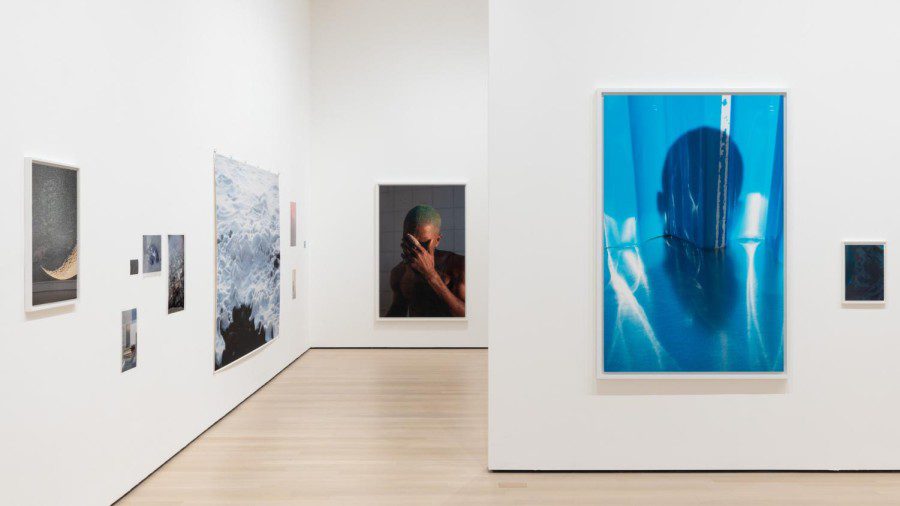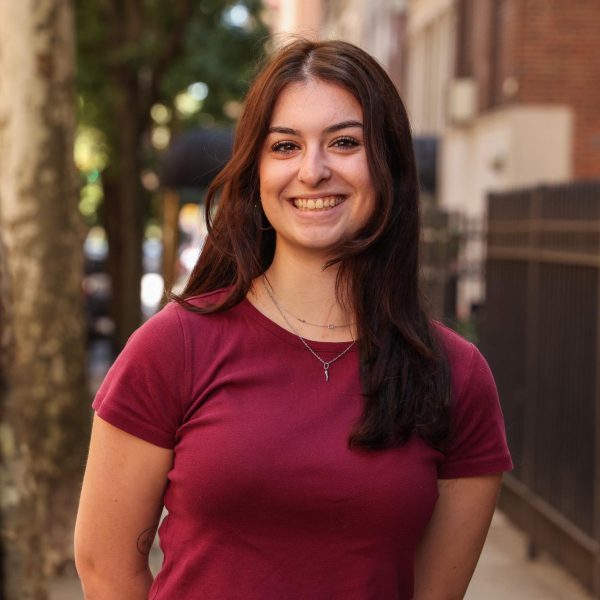Wolfgang Tillmans shares his fearless perspective of the world in new MoMA installation
Wolfgang Tillmans’ ‘To look without fear’ blurs the line between aesthetics and politics.
Installation view of “Wolfgang Tillmans: To look without fear,” on view at the Museum of Modern Art, New York from Sept. 12, 2022 to Jan. 1, 2023. (Photo by Emile Askey, courtesy of the Museum of Modern Art)
September 26, 2022
On Sept. 12, the line for The Museum of Modern Art went around the block, even before its 10:30 a.m. opening. Many of those waiting carried cameras, notebooks and laptops in order to document their experiences. The opening of Wolfgang Tillmanns’ “To look without fear” had been postponed for 18 months due to the pandemic. The exhibit’s inauguration reflects its message — bringing about “connections and the idea of togetherness.”
In contrast to the traditional framing and mounting of other photography exhibits, Tillmans’ photos are taped to the wall. There seems to be no reasoning for this arrangement, perhaps to give the impression that each piece — no matter the size — has a place in the collection. None of the pieces have labels or an explanation from Tillmans, aside from inconspicuous pamphlets located at the entrance — only there will you find the titles and descriptions. Tillmans’ work urges the audience to first look at it on their own terms, and only learn more about the piece if desired.
Casual intimacy in human life and relationships is prevalent throughout the collection. The human bodies on display are just that: bodies. They are not sexualized or manipulated, they just exist. “The Cock (kiss),” a photograph of two men kissing, circulated widely in the aftermath of the Orlando nightclub shooting in 2016. The image reflects Tillmans’ belief that intimacy and beauty are often politically charged, whilst merely portraying the two young men.
The more one learns about Tillmans, the deeper meanings his photos gain. This is particularly true with the piece “17 years’ supply.”’ Photographed is a cardboard box of empty medicine bottles. It is seemingly mundane, until one learns of Tillmans’ struggle with HIV, and lost a partner to HIV-related pneumonia. The piece reflects the effort it takes for Tillmans to keep his illness at bay, while furthering his assertion that everything is inherently political. The difference between a man with HIV in 1997, and a man with HIV in 2022, is quite literally life or death.
Tillmans’ striking otherness becomes clear through one of the main rooms of the exhibition titled “Soldiers — The Nineties at Masculinities: Liberation through Photography.” In this room, there are many different newspaper clippings, photographs and magazine covers taped to the emergency door in the corner. The images featuring popular news clips during the ’90s that belittled or demonized gay culture, while highlighting the achievements of straight, patriarchal figures — seen in military men and haughty presidents — reflect the ways in which Tilmans’ identity as a gay artist has been negatively affected by the political opinion of others.
The ’90s in America are remembered by big hair, even bigger computers and Monica Lewinsky’s unfortunate mistakes. Whereas for Western Europe, the decade brings memories of being torn apart.
The newspaper articles are in many different languages, but no translation is offered — an abrupt realization that language barriers are embedded in the world. One is pulled through time when reading each paper. The countries depicted in this installation are Kuwait, Bosnia and Herzegovina, Serbia and East Timor/Timor-Leste. In contrast, American news reports on the war feature photos of young men in uniforms taking part in leisurely activities such as playing cards and smoking cigarettes.
Viewing these newspaper clippings gives the viewer a different perspective of each photo. A collection of planes flying reads as grim due to its ties to the Cold War, rather than lighthearted and boyish. Two men kissing among the clippings depicts an act of defiance rather than love. Such an abrupt shift in tone again reflects this sort of “visual democracy” that Tillmans tries to display.
One of the final rooms in the installation is titled “Truth Study Center.” The room is empty except for a maze of wooden tables covered in different printed media. There are photographs, poems, doodles, book pages and even a quote from NYU’s own mathematics professor Lai-Sang Young about the mystery of human vision.
“Truth Study Center” is a magnificent representation of the overwhelming amount of information that modern media presents us with. What was once important is no longer trending two hours later. The viewer could spend hours in the single room and still not see everything. The permanence of these items, and their collection, emphasizes the beauty of small things and their details.
One of the final photographs is titled “Frank, in the shower.” This is most commonly recognized as artist Frank Ocean’s artwork for his album “Blonde.” Young audiences flocked to the image, whereas middle-aged museum visitors failed to make the connection to Ocean.
Seeing Tillmans’ early photography, his experiments throughout the ‘90s and his recent collaborations with popular queer artists like the aforemention Ocean, his importance as a leading queer activist working within the arts becomes immediately apparent. After 30 years in the art world, it is an admirable feat that Tillmans has works that cater to all generations, despite the fleetingness of time he so desperately tries to capture.
“To look without fear” is available for viewing from Sept. 12, 2022, to Jan. 1, 2023 at MoMA
Contact Julia Diorio at [email protected].

























































































































































